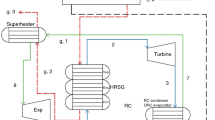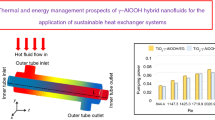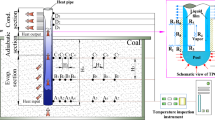A NaNO2/NH4Cl heat generating system has been widely applied in oil production process in China, for paraffin plug removal, in-situ fracturing, etc. Establishing an accurate kinetic equation for the NaNO2/NH4Cl system is important for field operation applications. In this study, based on a strictly controlled group of experiments, the kinetic equation for the NaNO2/NH4Cl heat generating system is established and regressed by the method of undetermined coefficients, on condition that the heat loss of the reaction is relatively small and could be neglected. It is obvious that in many field applications the heat loss is considerably high and cannot be neglected; hence the equation is improved by taking into consideration the heat loss input. The improved equation shows a better correlation with experimental data, particularly for long reaction times. The established equation reveals the relationship between the reaction rate and the concentrations of the reactants and catalyst This study has practical significance for calculating the temperature field near the well bore and can be used for parameter optimization of the NaNO2/NH4Cl heat generating system.
Similar content being viewed by others
Avoid common mistakes on your manuscript.
Introduction
Chemical heat generation is used to improve the oil recovery and the fluidity of oil in the formation using the heat generated in the exothermic chemical reaction. In recent years, chemical heat generating methods have been widely applied in oilfield development and have shown good effectiveness for in-situ heat fracturing, paraffin plug removal, surface cleanup, and thermal chemical flooding in heavy oil reservoirs [1,2,3,4,5,6,7,8].
There are three kinds of chemical heat generating systems commonly used in oil production, namely NaNO2/NH4Cl, H2O2, and polyhydroxyaldehyde/CrO3. Numerous studies have been conducted on these chemical heat generating systems. Huang et al. [9] compared three heat generation systems and concluded that the NaNO2/NH4Cl system has a much lower corrosion rate. Davies et al. [10] suggested that the NaNO2/NH4Cl system has a considerably larger heat generating capacity in the presence of iron ions. To summarize, the NaNO2/NH4Cl system is characterized by higher heat generation, higher safety factor, lower corrosivity, lower formation damage, and lower costs, compared with other chemical heat systems [11–16]. However, the results of the previous researchers as presented in the literature differ significantly. Furthermore, little attention was paid to investigation of the kinetics.
In this paper, experiments on the ammonium chloride/sodium nitrite reaction were performed, which showed good repeatability. Citric acid was used as a catalyst. The kinetic equations with or without the heat loss consideration were then established and improved to reveal the relationship between the reaction rate and the concentrations of reactants and the catalyst.
1. EXPERIMENTAL DESIGN
1.1 Experimental equipment and materials
The experimental equipment included a high pressure/high temperature reaction vessel JBF-2, a temperature and pressure monitor, and a temperature controlling device. The chemicals used in the experiments include NH4Cl, NaNO2, C6H8O7, and distilled water.
1.2 Experimental procedure
-
(1)
Prepare 50 mL NH4Cl solution of a certain concentration and add citric acid. Introduce the solution into the chamber of the reactor.
-
(2)
Prepare 50 mL NaNO1 solution of the same concentration and introduce the solution into the container hanging above the chamber.
-
(3)
Set the initial reaction temperature of the system
-
(4)
Mix the two solutions instantly by turning the handle on top of the reactor and keep stirring gently for better mixing. Observe and record the temperature and pressure in the reactor during the reaction.
-
(5)
Change one of the reaction parameters (the initial reactant concentration, catalyst concentration, or the initial reaction temperature), and repeat steps 1-4.
2. KINETIC EQUATION REGRESSION
2.1 Assumptions
-
(1)
The heat loss is neglected. The experimental reaction data with low heat loss values were selected for regression. The heat loss is defined as the heat that is not absorbed by the liquid phase.
-
(2)
The effect of side reactions is neglected.
-
(3)
The obtained gas temperature is equal to that of the liquid phase during the reaction.
-
(4)
The specific heat of the solution is assumed to be equal to the specific heat of water, which is 4.2 LT/(kg·K).
2.2. Kinetic equation regression procedure
As was established in the literature, there are two types of kinetic equations for the ammonium chloride/sodium nitrite system, respectively shown as Eqs. (1) and (2) [16-17]. Both equations were obtained by combining the Arrhenius empirical formula with the experimental results. Both equations used the same parameters, including the half-life of the reaction (t1/2), the reaction order (n), the reaction rate constant (KT), the relationship between KT and the concentration of H+, and the reaction activation energy (Ea).
The difference between the coefficients in Eqs. (1) and (2) reflects the fact that the kinetic equation accuracy is strongly affected by the particular experimental conditions at the oil field. The two equations have the same mathematical form revealing the relationship between KT and the concentration of H+, as represented by Eq. (3). In our study the coefficients k0, k1, m, n in Eq. (3) were obtained based on the experimental data. The method of undetermined coefficients was used for regression:
where dC/dt is the reaction rate of NaNO2 (or NH4C1), mol/(L-min); C is the concentration of NaNO2(or NH4C1); when t = 0, then C = Co, mol/L; \( {C}_H^{+} \) is the mass concentration of catalyst in the mixed solution, wt.%; and T is temperature of the mixed solution, K
The temperature and pressure readings are recorded during the reaction. According to the energy conservation law, the heat generated by the reaction is divided into two parts: the heat absorbed by the liquid phase and the heat loss absorbed by the reactor body. The energy conservation equation is the following:
where 2ρvcp(T–T0) is the heat absorbed by the solution; \( {\int}_{t_0}^t2q(t) vdt \) is the heat loss; (C0–C)Hv is the total heat generated by the reaction; ρ is the density of the mixed solution, 103kg/m3; v is the volume of the solution of NaNO2 (or NH4C1), L; C0 is the initial reactant concentration (before mixing), mol/L; cp is the specific heat of the mixed solution, kJ/(kg·K); T0 is the initial reaction temperature, K; H is the reaction enthalpy, 332.58 LT/mol; q(t) is the rate of heat loss per volume of the mixed solution, kJ/(L·min).
Equation (4) can be transformed mathematically, so the reactant concentration is expressed as
When the heat loss is neglected, \( {\int}_{t_0}^t2q(t) vdt=0 \), Eq. (5) is written as
Here C can be calculated by Eq. (6), and.dC/dt can be calculated by the numerical method of weighted difference, as shown below:
Citric acid is an organic acid, which can partially ionize in water. It is selected as a catalyst for its low corrosivity to the wellbore and reservoir. The ionization equilibrium constant depends on the temperature; thus the molar concentration of the hydrogen ions also changes with the temperature. To keep CH+ as a constant, mass concentration (wt.%) is used instead of molar concentration of hydrogen ions (mol/L). Finally, the equation was regressed using the nonlinear least squares method and substituted into the expressions for dC/dt, CH+(wt.%), and C into Eq. (3).
2.3 Kinetic equation regression results
As shown in Table 2, the eight groups of experimental data meeting the criterion of negligible heat loss were selected for regression. Using the data from multiple experiments helped to avoid the multi-solution problem during regression.
Hence, the kinetic equation of the ammonium chloride/sodium nitrite reaction exclusive of the heat loss is
2.4 Accuracy of the regressed kinetic equation
In practice, heat loss is inevitable no matter what kind of reaction device is used. In order to check the accuracy of the above kinetic equation and to evaluate the influence of the heat loss on the heat generation process, two groups of experimental data were selected, as shown in Table 3. The experimental parameters differ significantly. Then Eq. (8) is solved by the fourth-order Runge-Kutta method. For Exp. No.9, the peak temperature time is only 19 s, while for Exp. No.10, it is 291 s. A comparison between the measured and calculated values for experiments Nos.9 and 10 is shown in Figs.1 and 2, respectively.
As shown in Fig.1, the fitted curve (red line) strongly correlates with the experimental data (blue line), and the average relative deviation is 2.49%, as shown in Table 4. The kinetic equation satisfies the requirements of accuracy.
As shown in Fig.2, the relative error is comparatively high. The longer reaction time in Exp. No.10 causes a larger heat loss when compared with Exp.No.9. Thus, the heat loss has a great impact or the accuracy of the equation, and the longer the time to reach the peak temperature, the larger the error.
3. EMPROVED KINETIC EQUATION
For field application, when the heat loss in the wellbore and the formation is large and cannot be neglected, the prediction of heat generation performance by Eq. (8) could cause a large deviation. In order to improve the accuracy of the kinetic equation, the effect of the heat loss should be considered. The improved equation could then be applied for calculating the temperature field in the formation and optimizing parameters of the heat generating system.
3.1 Mathematical model incorporating heat loss
Integrate Eq. (3) to obtain the analytical expression of reactant concentration as a function of time:
The differential form of the energy conservation equation in the reactor is
Substituting Eq. (9) into Eq. (10), and considering Eq. (11), we obtain
Integrate Eq. (12) to obtain
Differentiate Eq. (13) with respect to t:
Multiply Eq. (14) by dt, and then integrate it to obtain
The heat loss rate is derived as a function of temperature T, that is. q(t) = g(T). Differentiate Eq. (15) with respect to T. Then the reciprocal expression is
Equation (5) after mathematical transformation takes the form
Substituting Eq. (17) into Eq. (16), we have
Differentiate Eq. (17) with respect to t, and then substitute Eq. (17) into Eq. (18):
Substituting the coefficients of Eq. (8) into Eq. (19), we have
The resulting equation represents a generalized expression incorporating the effect of the heat loss for different reaction conditions. When the heat loss can be neglected, meaning g(T) = 0, Eq. (20) is simplified to Eq. (8).
3.2 Heat loss function
The key for obtaining the improved kinetic equation of the NaNO2/NH4Cl system is to get the heat loss function g(T). The function g(T) may have different forms for different laboratory or reservoir conditions. In order to establish the heat loss function, the following three groups of experimental data were selected, as shown in Tables 5 and 6.
For the above three groups of time and temperature data, the value of dT/dt was calculated. As shown in Fig.3, the relationship between the temperature change rate dT/dt and (TT0) is linear, and the correlation coefficient is high, 0.985.
For the laboratory conditions, the relationship between the temperature change rate dT/dt and the temperature T is expressed as
Substituting the a and b values from Fig. 3 into Eq. (21), we obtain the expression of the heat loss function g(T)
3.3 Validation of improved kinetic equation
After substituting Eq. (22) into Eq. (20), the final equation was solved by the fourth-order Runge-Kutta method, and the resulting curve is added to Fig. 2. As shown in Fig. 4, the temperatures calculated by the kinetic equations with and without the effect of heat loss differ significantly. The improved kinetic equation curve (green line) shows a strong correlation with the experimental data from Exp.No.10 (blue line).
It can seen that the improved kinetic equation is characterized by good accuracy. Equation (8) is accurate when the effect of heat loss can be neglected. When the heat loss is considerable, the improved kinetic equation should be applied.
4. IMPLICATIONS FOR FIELD PRODUCTION
For low-permeability reservoirs, the precipitates of wax, asphaltenes, and inorganic salts may cause pore plugging in the formation and thus decrease the productivity or injectivity of the wells. In the process of water flooding, the water-lock phenomenon is very likely to happen, causing a decrease in the relative permeability of oil. The chemical heating technology proves to be the most effective and economical way to remove plugs and to increase oil production. Successful application of the chemical heating technology in the field operation needs optimization of the chemical reaction parameters. Parameters such as the concentration of the reactants and the catalyst, the initial temperature, and the heat loss affect the peak temperature in the reservoir. The heat loss reduces the total chemical heat that can be absorbed by the oil, lengthens the time to achieve the peak temperature, and changes the temperature profile in the reservoir. As shown in this study, the theoretical kinetic equation with consideration of the heat loss equation g(T) proves to be accurate in predicting the effectiveness of the chemical reaction and its application for plug removing in the field.
5. CONCLUSIONS
In this paper, NaNO2/NH4Cl chemical heat generation experiments are conducted, and an improved kinetic equation is established with consideration of the effect of heat loss. The following conclusions are drawn:
- 1
The kinetic equation of the ammonium chloride/sodium nitrite system is regressed as dC/dt = −2.63 × 107\( {C}_{H^{+}}^{0.9}{\mathrm{e}}^{-6178/T}{C}^{2.3} \). It shows good accuracy when the effect of heat loss can be neglected, which is the case when the reaction time is short.
- 2
A generalized form of the kinetic equation with consideration of heat loss impact for different conditions is obtained by introducing the heat loss function g(T):
where g (T) = 2.65\( {e}^{0.2\left(T-{T}_0\right)} \). The improved equation provides a more accurate fitting to experimental data for both short and long reaction times.
- 3
The combination of the mathematical model and the numerous experimental data, as proposed in this paper, can be successfully used for parameter optimization and prediction of the temperature distribution in field applications of the heat generation method.
References
T. Mitchell et al., “Field Application of a Chemical Heat and Nitrogen Generating System,” paper SPE 12776 presented at the 1984 SPE California Regional Meeting, Long Beach, April 11-13, (1984).
J.B. Collesi, T.A. Scott, and H.W. McSpadden, "Surface equipment cleanup using in-situ heat," SPE Product. Eng., 3(02), 258-262 (1988).
Y. Huang, C. Pu, and F. Wu, "Calculation of temperature field in heavy oil reservoirs with steam injection and chemical thermogenesis,"Appl. Chem. Ind., 41(2), 365-368 (2012).
S. Liu, A Sun, F. Liu, et al, "Optimization methods of concentration of heat-generation agents in in-situ heat fracturing treatment," Oil Drill. Prod. Technol., 25(1), 45-48 (2003).
Y. Lin, L Xiang, and Y. Huang, "Research and application of new types of foam fracturing fluid," Drill. Prod. Technol., 33(4), 99-101(2010).
Q. Zuo and X. Fan, "A method of thermochemical block removal for extra and super heavy oil reservoirs," Spec. Oil Gas Reserv., 19(1), 113-115 (2012).
J. Zhang, D. Wang, Q. Ma, et al., "Applied research on oil recovery technique by thermochemistry," OGRT, 6(4), 62-66 (1999).
A.A. Al-Taq et al., "First successful filtercake damage removal treatment utilizing in-situ nitrogen/heat generating system for relatively heavy oil wells," paper SPE170832 presented at the SPE Annual Technical Conference and Exhibition, Amsterdam, Netherlands, 27-29 October (2014).
J. Huang and X. Ju, "Study on three chemical heat generation systems and application in oilfield production," Technol. Supervis. Pet. Ind., 21(1), 58-60 (2005).
D.R. Davies, E.A. Richardson, and D. Antheunis, "Field application of in-situ nitrogen gas generation system," Middle East Technical Conference and Exhibition. Society of Petroleum Engineers (1981).
J. H. Bayless, “Hydrogen peroxide, a new thermal stimulation technique,” World Oil, 219(5), 75-78 (1998).
J. H. Bayless, "Hydrogen peroxide applications for the oil industry," World Oil, 221(5), 50-54 (2000).
X. Chen, L. Zhao, and S. Liu, "Laboratory experiment and application of chemical heat-generation," J. Chongqing Univ. Sci. Technol. (Nat. Set. Ed.), 14(3),113-114 (2012).
Y. Then, H. Ying, J. Han, et al., "Research on low corrosion of fracturing fluid in authigenic heat system in-door,"J. Shanxi Univ. Sci. Technol., (1), 62-65 (2013).
Acknowledgments
We would like to thank the National Key Basic Research Program of China (No. 2015CB250904) for financial support, and the China Oilfield Services Limited (COSL) for supporting this work
Author information
Authors and Affiliations
Additional information
Translated from Khimiya i Tekhnologiya Topliv i Meisel, No. 5, pp. 75 — 80, September — October, 2019.
Rights and permissions
About this article
Cite this article
Xiuyu, W., Yuqiao, C., Chang, L. et al. Improved kinetic Equations for a NaNO2/NH4Cl Heat Generating System and their Implications in Oil Production. Chem Technol Fuels Oils 55, 623–634 (2019). https://doi.org/10.1007/s10553-019-01075-9
Published:
Issue Date:
DOI: https://doi.org/10.1007/s10553-019-01075-9








